Information on the types and process of healing of the postoperative suture. And also told what actions you need to take in case of complications.
Contents
- Types of post-surgical sutures
- How and what to process the post-operative suture for better healing at home?
- How to remove postoperative sutures at home?
- What if there is a seal on the site of the postoperative suture?
- Postoperative suture does not heal, reddened, inflamed: what to do?
- Post-operative fistula: causes of appearance and methods of struggle
- Ointments for healing and resorption of postoperative sutures
- Plaster for healing of postoperative sutures
- Video: Treatment of postoperative suture
After a person has experienced surgery, scars and stitches remain for a long time. From this article you will learn how to properly handle the postoperative suture and what to do in case of complication.
Types of postoperative sutures
The surgical suture connects biological tissues. Types of postoperative sutures depend on the nature and extent of the surgical intervention and there are:
- bloodless , which do not require special threads, but are glued with a special plaster
- bloody , which are stitched with medical suture material through biological tissues
. Depending on the method of suturing bloody seamsthe following types:
- simple nodal - the puncture has a triangular shape that holds the suture
- continuously intracutaneous - the most common , which provides a good cosmetic effect
- vertical or horizontal mattress - used for deep extensive damages of the tissue
- pouch - designed for plastics
- wrapped - usually serves to connect the vessels and organs of hollow
From the fact,what technique and tools are used for suturing, differ:
- hand , when applied with a conventional needle, tweezers and other toolss. Suture materials - synthetic, biological, wire, etc.
- mechanical , carried out by means of the apparatus using special brackets
 Joints can impose different variants of
Joints can impose different variants of Depth and length of bodily injury dictates the method of laying the seam:
- single-row - the seam is laid in one layer
- multilayered -the overlap is performed in several rows( first the muscular and vascular tissues are combined, then the skin is sewn)
In addition, surgical sutures are divided into:
- removable - after the wound has healed, the joint material is removed( usually used on the coverslips)
- submersible - not removed( applicable for connecting internal tissues)
Materials used for operational joints can be:
- resorbable - removalsuture is not required. As a rule, when mucous and soft tissue ruptures of
- are not absorbed, they are removed after a certain period of time established by the doctor
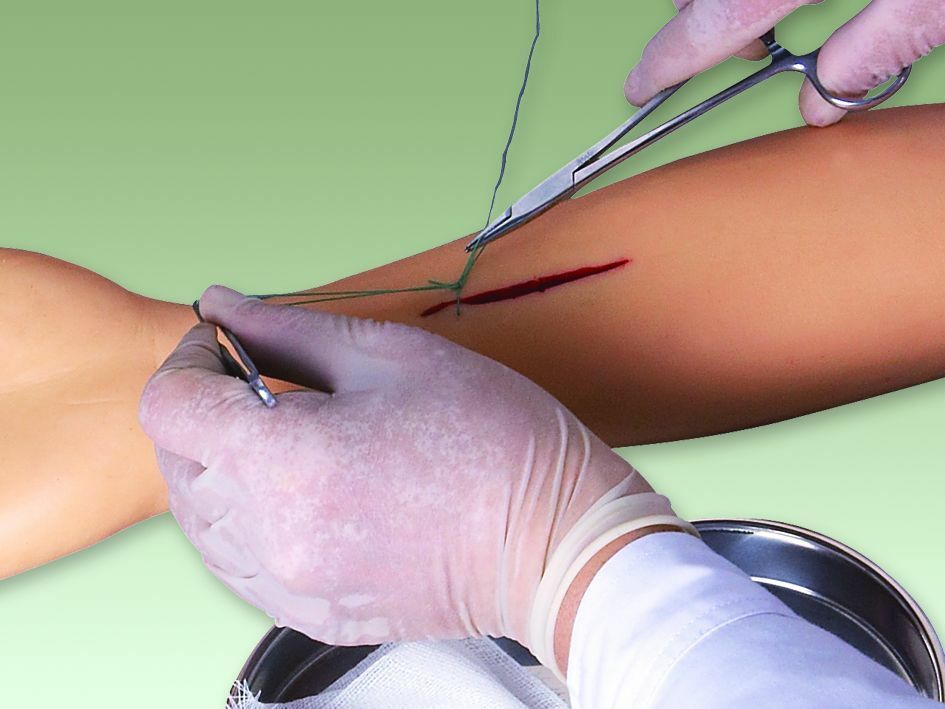 . Various materials are used for suturing
. Various materials are used for suturing . When applying seams, it is very important to connect the wound edges tightly so that the possibility of cavity formation is completely excluded. Any type of surgical suture requires treatment with antiseptic or antibacterial drugs.
How and what to process the post-operative suture for better healing at home?
The healing period of wounds after surgery depends largely on the human body: some people have this process quickly, others have a longer time. But the key to a successful outcome is proper therapy after suturing. The following factors influence the timing and nature of healing:
- sterility
- seam materials after operation
- regularity
One of the most important requirements of trauma care after operations is the compliance with the sterility of .Handle wounds only with carefully washed hands using disinfected tools.
Depending on the nature of the injury, the post-operative sutures are treated with various antiseptic agents:
- solution of potassium permanganate( it is important to observe the dosage to rule out the possibility of a burn)
- iodine( in a large amount can cause dry skin)
- green
- with medical alcohol
- fuccarcin( difficult to wipe off the surface, which causes some inconvenience)
- with hydrogen peroxide( can cause mild burning)
- with anti-inflammatory ointments and gels
 Sutures after operationit is necessary to handle
Sutures after operationit is necessary to handle Often in the domestic environment for these purposes, folk remedies are used:
- tea tree oil( in its pure form)
- tincture of the roots of the livid( 2 tbsp, 1 tbsp water, 1 tbsp alcohol)
- ointmenta glass of beeswax, 2 cups vegetable oil simmer on low heat for 10 minutes, allow to cool)
- cream with marigold extract( add a drop of rosemary and orange oils)
Before treatment, be sure to consult with your doctor. In order for the healing process to proceed as quickly as possible without complications, it is important to observe the rules for the treatment of the joints:
- disinfect the hands and tools that may be needed.
- , remove the wound from the wound gently. If it is stuck, apply
- peroxide with a cotton swab or gauze swab with grease the seam with
- antiseptic agent. Apply
 . Apply
. Apply sterilization. Also, do not forget to observe the following conditions:
- ,
- regularly inspect the wound for inflammation
- to avoid scars, do not remove dry crusts and scabs from the
- wound during showering do not rub the seam jesKimi sponges
- in the event of complications( purulent discharge, swelling, redness), immediately consult a doctor
Removing postoperative seams in the home?
Removable postoperative suture should be removed on time, since the material used to connect the tissue acts for the body with a foreign body. In addition, if the threads are not removed in due time, they can grow into tissues, which will lead to inflammation.
We all know that the must be removed by a medical professional under suitable conditions with the help of special tools .However, it happens that the opportunity to visit the doctor is absent, the time of removal of the sutures has already come, and the wound looks completely healed. In this case, you can remove the suture material yourself.
First, prepare the following:
- antiseptic preparations
- sharp scissors( preferably surgical, but can also use manicure)
- dressing material
- antibiotic ointment( in case of infection into the wound)
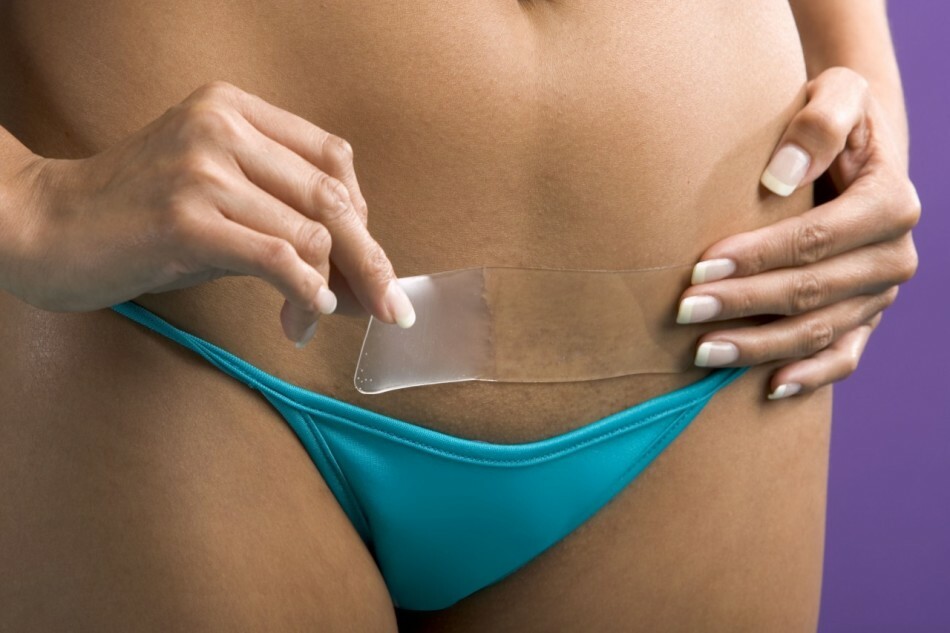 The seam can be removed and at home, but with the observance ofrules
The seam can be removed and at home, but with the observance ofrules Remove the seam process as follows:
- disinfect the tools
- thoroughly wash your hands on the elbow and treat with an antiseptic
- choose a well-lit place
- remove the bandage from the
- seam using alcohol or peroxide, treat the area around the seam
- with tweezers gently slightly lift the first
- knot by holding it with scissors cut the suture thread
- , gently, slowly pull the thread
- , proceed in the same order and further: lift the assembly and pull the threads
- make sure that you remove all the sutures
- treatment treat the joint site with an antiseptic
- , apply a bandage for better healing of the
 . But, better entrust this matter to a professional
. But, better entrust this matter to a professional . In case of self-release of postoperative sutures, in order to avoid complications, strictly observe the following requirements:
- remove only small superficial seams
- Do not remove at home surgicalBrackets or wire
- make sure that the wound is fully wound
- if the blood goes off during the process, stop the operation, owork antiseptic and consult a doctor
- take care of the seam region of ultraviolet radiation, as the skin there is too thin and prone to burns
- avoid this area the possibility of injury
What if on the ground appeared postoperative joint seal?
Often the patient under the seam undergoes compaction, which is formed due to the accumulation of lymph. As a rule, it does not pose a threat to health and eventually disappears. However, in some cases complications can occur in the form of:
- of inflammation of - accompanied by painful sensations in the seam area, redness is observed, the temperature of
- suppuration of may increase - with the inflammation in progress, pus can be isolated from
- wound of keloid scars formation -but has a non-aesthetic appearance. Such scars can be removed by laser resurfacing or surgically
. If you observe these signs, consult your surgeon. And in the absence of such an opportunity, - to the hospital at the place of residence.
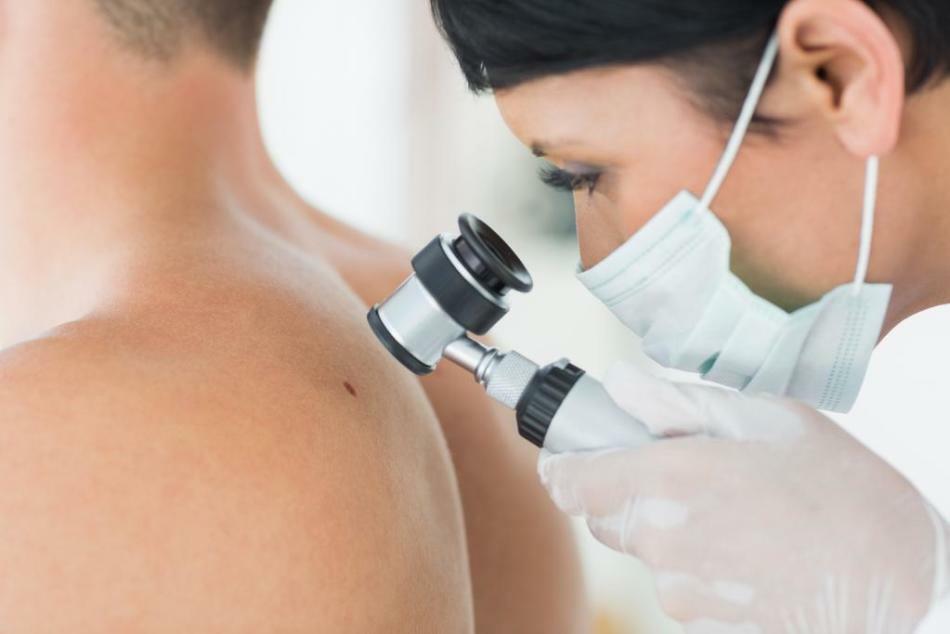 If you see a seal, consult a doctor
If you see a seal, consult a doctor . Even if it subsequently turns out that the cone is not dangerous and eventually dissolves on its own, the doctor should check and give his opinion. If you are convinced that the seal of the postoperative suture is not inflamed, does not cause pain and purulent discharge is absent, fulfill the following requirements:
- observe hygiene rules. Do not allow bacteria to enter the injured area
- treat the joint twice a day and change the dressing material
- in a timely manner taking a shower, avoid getting water on the unhealed area of the
- . Do not lift the
- gravity. Take care that your clothes do not rub the seam and the areola around it
- before, how to get out on the street, apply a protective sterile bandage
- do not apply compresses and rub off various tinctures according to the advice of acquaintances. This can lead to complications. Prescribe the treatment should the doctor
 Observe hygiene after surgery
Observe hygiene after surgery Compliance with these simple rules is the key to successfully treating seam seals and the possibility of getting rid of scars without surgical or laser technologies.
Postoperative suture does not heal, reddened, inflamed: what to do?
One of a number of postoperative complications is suture inflammation. This process is accompanied by such phenomena as:
- edema and redness in the joint
- pain
- presence under the seam of the seal, which is groped by the fingers
- increase in temperature and blood pressure
- general weakness and muscle pain
Causes of the inflammation and further non-healing of the postoperative suture can bedifferent:
- infection in the
- postoperative wound during the operation injured subcutaneous tissues resulting in the formation of hematomas
- suture material had increased reactivity of the
- tissue in overweight patients wound drainage was not sufficient
- low immunity in the operated
There are often a number of listed factors thatcan arise:
- because of the error of the operating surgeon( the tools and materials were not sufficiently processed)
- the patient's non-compliance with
- post-operative requirements due to indirect infection in which microorganisms are carried through the blood from another inflammatory focus in the body
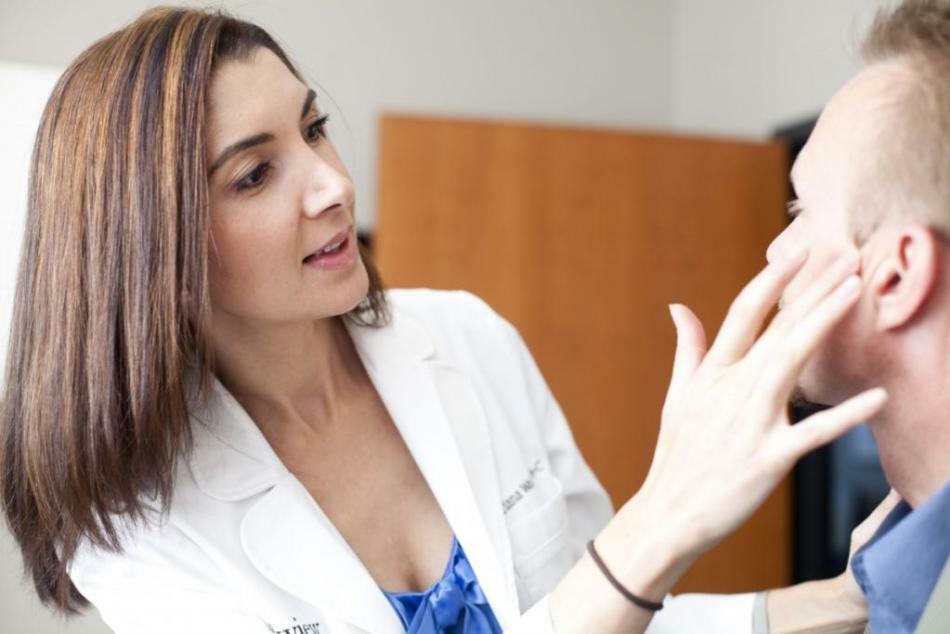 If you see redness of the seam, contact
If you see redness of the seam, contact immediately. In addition, the healing of the surgical suture depends on the individual body:
- - in full people the wound after surgery can heal more slowly
- of age - regeneration of tissues at a young age occurs faster
- pitNia - a lack of protein and vitamins slows the recovery process
- chronic diseases - their presence prevents rapid healing
If you're watching at the redness or inflammation of the postoperative suture, do not delay visit to the doctor. The specialist should examine the wound and prescribe the correct treatment: the
- will remove the joints if necessary.
- will wash the wounds.
- will install drainage to purge septic discharge.
- will prescribe the necessary external and internal medicine.
Timely implementation of necessary measures will prevent the possibility of severe consequences( sepsis, gangrene).After the medical manipulations of the attending physician to speed up the healing process at home, follow these recommendations:
- treat the seam and the area around it several times a day with those medications prescribed by the physician
- during the shower, try not to touch the wound with a washcloth. After leaving the bath, gently blot the seam with a bandage
- in time to change the sterile dressings
- take the multivitamin preparations
- include in your diet an additional portion of the protein
- do not lift heavy objects
 Take vitamins to make the seam better tightened
Take vitamins to make the seam better tightened In order to minimize the risk of inflammation, beforethe operation needs to take preventive measures:
- increase immunity
- perform sanation of the mouth
- reveal the presence of infections in the body and take measuresto get rid of them
- strictly follow the hygiene rules after operation
Postoperative fistula: the causes of the appearance and methods of fighting
One of the negative consequences after surgery is postoperative fistula , which is a channel in which purulent cavities are formed. It arises as a consequence of the inflammatory process, when there is no outlet for a purulent fluid.
The causes of the appearance of fistulas after the operation may be different:
- chronic inflammation
- is not completely eliminated infection
- rejection by the body of the suture non-absorbable material
The last reason is the most common. The threads that connect the tissues during surgery are called ligatures. Therefore, the fistula, which arose because of its rejection, is called ligature. Around the thread, of the granuloma is formed, that is, a seal consisting of the material itself and fibrous tissue. This fistula is formed, usually for two reasons:
- getting into the wound of pathogenic bacteria due to incomplete disinfection of threads or tools in operation
- the weak immune system of the patient , due to which the body weakly resists infection, and there is a slow recovery after the introduction of a foreign body
Fistula can manifest itself in a different postoperative period:
- within a week after surgery
- in a few months
Signs of fistula formation are:
- redness in the area of inflammation
- appearance of seals and tubercles near the seam or on it
- painful sensations
- edema
- discharge of pus
- rise in temperature
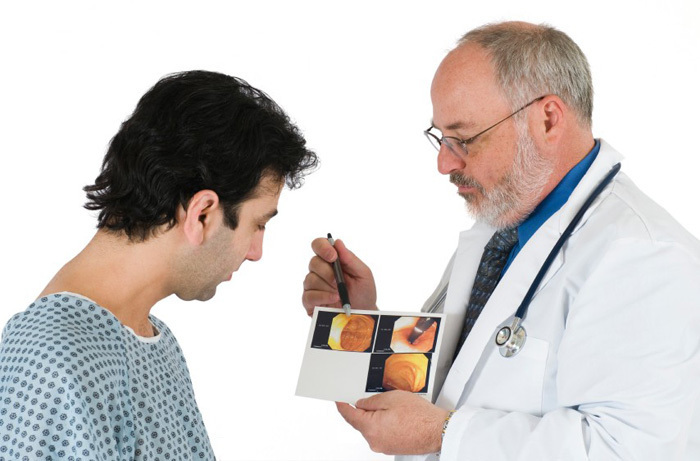 After surgery, very unpleasantphenomenon - fistula
After surgery, very unpleasantphenomenon - fistula In case of observing the listed symptoms, be sure to consult a doctor. If the time is not taken, the infection can spread throughout the body.
The treatment for postoperative fistulas is determined by a physician and can be of two types:
- conservative
- surgical
The conservative method is used if the inflammatory process has only begun and did not lead to serious disturbances. In this case, the following is done:
- removal of dead tissues around the seam
- washes the wound from the pus
- removes the outer ends of the filament
- receives the patient with antibiotics and immunoadigating agents
The surgical method includes a series of medical measures:
- cut for the pus outage
- remove the ligature
- rinse the wound
- if necessary, after a few days, the procedure is performed again
- in the presence of multiple fistulas. You may be given a complete excision of the
- suture. The seams are re-applied
- prescribes a course of antibiotics and anti-inflammatory drugs
- prescribed complexes of vitamins and minerals
- standard therapy is performed, appointed after surgery
 Fistula often has to be removed operably
Fistula often has to be removed operably Recently a new method of treatment of fistulas - ultrasonic. This is the most gentle method. The disadvantage of it can be called the duration of the process. In addition to these methods, healers offer folk remedies for the treatment of postoperative fistulas:
- mummy is dissolved in water and mixed with aloe juice. Dampen the bandage in the mixture and apply to the inflamed area. Hold several hours
- rinse the wound with digestion ( 4 tablespoons dry leaves per 0.5 liters of boiling water)
- Take 100 g of medical tar from , butter, honey of flower, pine resin, chopped aloe leaf. All mix and heat on a water bath. Dilute with medical alcohol or vodka. Apply the prepared mixture around the fistula, cover with a film or plaster
- , apply cabbage leaf
 at night on the fistula. Fistula can be removed and folk remedies
at night on the fistula. Fistula can be removed and folk remedies . However, do not forget that folk remedies are only an auxiliary therapy and do not cancel the visit to the doctor. To prevent the formation of postoperative fistulas, it is necessary:
- before the operation to conduct a patient's examination for the presence of diseases
- prescribe antibiotics for the prevention of infection
- carefully treat the instruments before operation
- prevent contamination of the suture materials
Ointments for healing and resorption of postoperative sutures
For resorption and healing of postoperative suturesapply antiseptic means( zelenok, iodine, chlorhexidine, etc.).Modern pharmacology offers other preparations of a similar property in the form of ointments for local effects. Their application for home-healing purposes has several advantages:
- availability of
- a wide range of action
- fat base on the wound surface creates a film that prevents overdrying of the tissues
- skin nutrition
- usability
- softening and lightening of scars
It should be noted that for moist dermal woundscover the use of ointments is not recommended. They are appointed, when the healing process began, has already begun.
Based on the nature and depth of skin lesions, various types of ointments are used:
- simple antiseptic ( for shallow superficial wounds)
- with hormonal components( for extensive, with complications)
Next we will consider the most popular ointments that are prescribed for the treatment of stitches afterOperations:
- Ointment Vishnevskogo - one of the most accessible and popular pulling funds. Promotes accelerated release of purulent processes
- levomekol - has a combined effect: antimicrobial and anti-inflammatory. It is a wide-spectrum antibiotic. It is recommended for purulent discharge from the
- seam is vulcanized - a product based on natural components. It is applied both to the wound and to the
- levosin bandage - kills the microbes, removes the inflammatory process, helps to accelerate the healing of
- , stellanin - a new generation ointment that cleans the puffiness and kills the infection, stimulates the regeneration of the skin
- epland - one of the strongest meanslocal treatment. Has analgesic and anti-infectious effect
- solkoseril - available as a gel or ointment. The gel is used when the wound is fresh, and the ointment - when the healing began. The drug reduces the likelihood of scarring and scarring. It is better to apply
- Actovegin under the bandage - a cheaper analog of solcoseryl. Successfully fights inflammation, almost does not cause allergic reactions. Therefore, it can be recommended for use by pregnant and lactating women.
- agrosulfan can be applied directly - it has a bactericidal effect, has an antimicrobial and analgesic effect.
 Ointment for the treatment of
Ointment for the treatment of seams. They are well recommended as a sucking agent for such medications:
- naftaderm - has an anti-inflammatory property. In addition, relieves pain and softens scars
- contractubex - is used when the healing of the joint begins. Has a softening smoothing effect in the scar zone
- mederma - improves the elasticity of the tissues and brightens the scars
 Excellent resolving agent
Excellent resolving agent The listed medicines are prescribed by the doctor and used under his supervision. Remember that self-treatment of postoperative sutures can not be done to prevent the suppuration of the wound and further inflammation.
Plaster for healing of postoperative sutures
One of the effective means for the care of postoperative sutures is a patch made on the basis of medical silicone. It is a soft self-adhesive plate that fits on the seam, connecting the edges of the fabric, and is suitable for small damage to the skin.
Advantages of the use of the plaster are as follows:
- prevents wounding of pathogens
- absorbs the discharge from the wound
- does not cause irritation
- breathable, thanks to which the skin under the patch breathes
- promotes softening and smoothing of the scar
- well retains moisture in the tissues, preventing drying
- preventsScarring
- is easy to use
- does not take place when removing the skin trauma patch
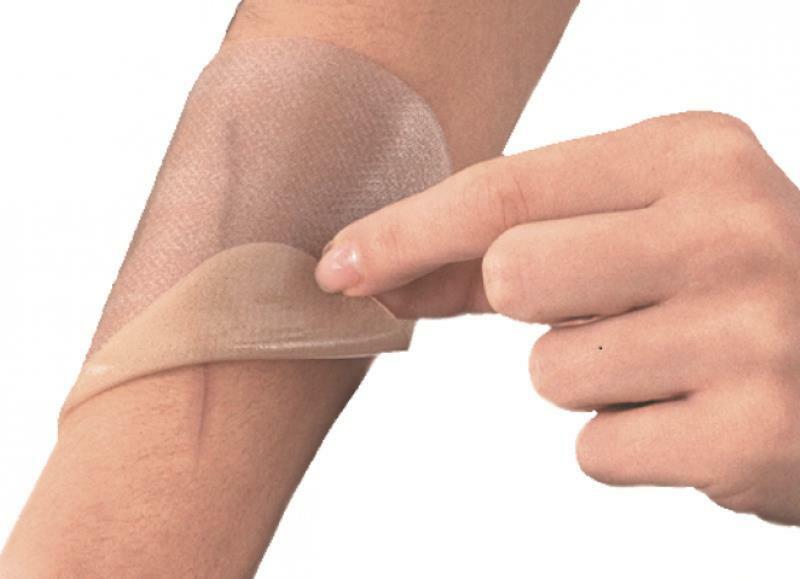 Plaster afteroperating
Plaster afteroperating Some plasters are waterproof, which allows the patient to take a shower without risking the seam. The most commonly used are the following plasters:
- cosmopore
- mepilex
- mepitac
- hydrophilic
- fixopor
To achieve positive results in the healing of postoperative sutures, this medical device must be applied correctly:
- remove the protective film
- with the adhesive side attach to the weld area
- change every other day
- periodically patch the patch and check the wound condition
We remind you that before using any pharmacological agent, you should consult a doctor.
